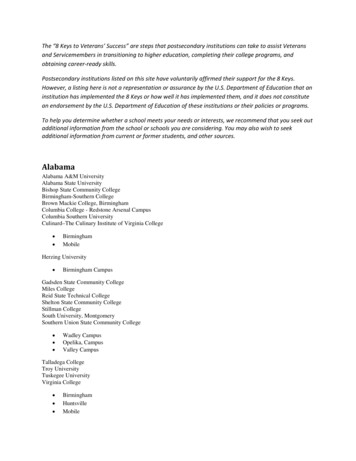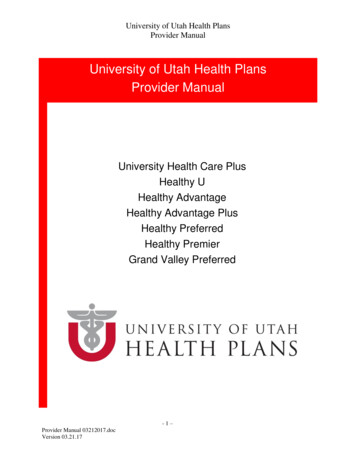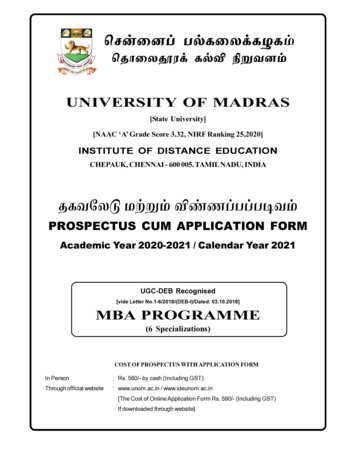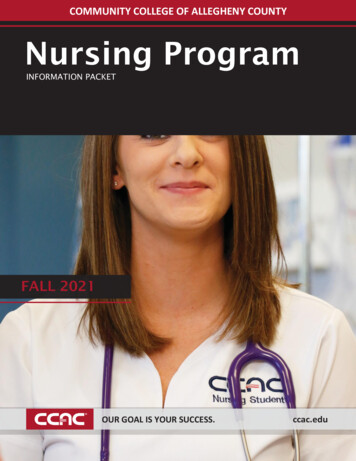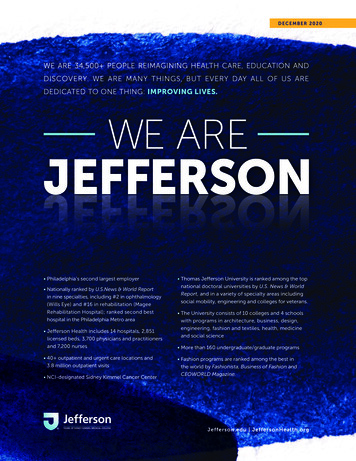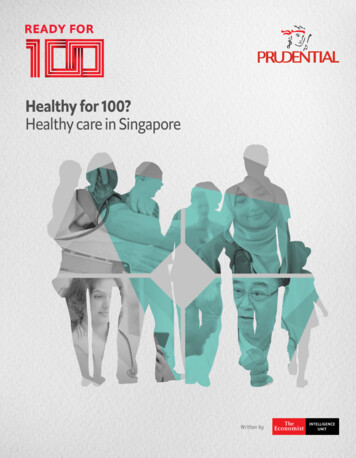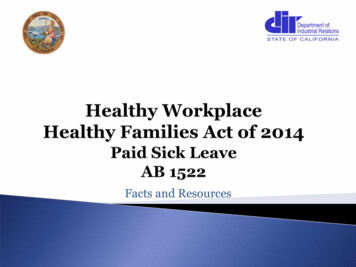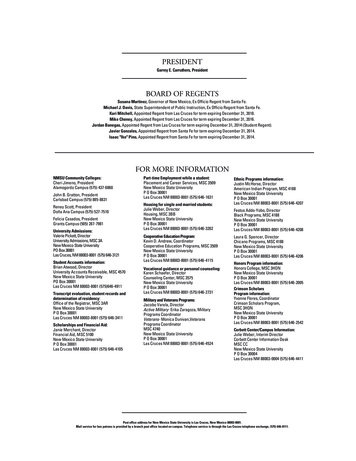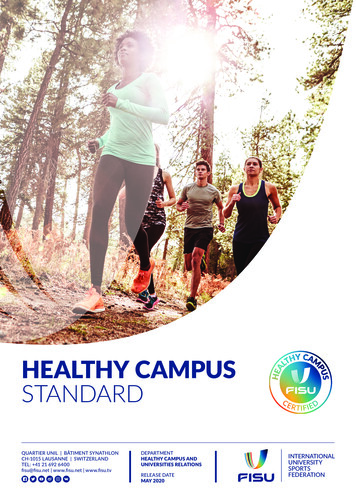
Transcription
HEALTHY CAMPUSSTANDARDQUARTIER UNIL BÂTIMENT SYNATHLONCH-1015 LAUSANNE SWITZERLANDTEL: 41 21 692 6400fisu@fisu.net www.fisu.net www.fisu.tvDEPARTMENTHEALTHY CAMPUS ANDUNIVERSITIES RELATIONSRELEASE DATEMAY 2020INTERNATIONALUNIVERSITYSPORTSFEDERATION
HEALTHY CAMPUSSTANDARDPUBLISHED BYHEALTHY CAMPUSAND UNIVERSITIESRELATIONScontact personFERNANDO PARENTEDIRECTOR OF HEALTHY CAMPUSAND UNIVERSITIES RELATIONShealthy.campus@fisu.netFISU HEADQUARTERSInternational UniversitySports FederationQuartier UNIL-CentreBatîment SynathlonCH-1015 Lausanne SwitzerlandTel 41 (0)21 6926400This document is notfor public distribution and remainsthe property of FISU
HEALTHY CAMPUSSTANDARDCOPYRIGHTThis document is protected by copyright in favourof the International University Sports Federation.No part of this publication may be reproduced orused in any form whatsoever and by no means,electronic or mechanical, including photocopy,scan and microfilm, without the owners’ writtenauthorisation. Requests for authorisation are to beaddressed to: healthy.campus@fisu.netSTANDARDISATIONPROCESSThis standard has been developed by the International University Sports Federation, with the guidance and technical support of Evaleo* and througha consultation process involving a group of over 30world-renown experts in the domain of standardisation and certification process, quality management systems, physical activity and sport, nutrition,disease prevention, mental and social health, riskbehaviour, environment, sustainability and socialresponsibility.Any reproduction is subject to royalties or licencingagreements. Offenders are liable to legal actionLIST OF EXPERTSThe following experts participated in the elaboration of this standardisation schemeNameFirst NameCountryOrganisationBaldwinMarkThe NetherlandsUtrecht UniversityBazavlukSergey V.RussiaRUDN MoscowCapranicaLauraItalyUniversità degli Studi di Roma "Foro Italico"CartyCatherineIrelandInstitute of technology TraleeCarvalhoJoanaPortugalUniversidade do PortoDalrympleAlisterFranceEvaleo NathalieSwitzerlandEuropean Association for the Study of ObesityFitzpatrickIanAustraliaUniversity Western Australia, Sport departmentGordinEmilianoArgentinaFederación del Deporte Universitario ArgentinoGrossMichaelSwitzerlandEvaleo AssociationHoggConradAustraliaUWA Student GuildLaflinMikeUnited KingdomGlobal Sports StrategiesLuttikJokeNetherlandsWageningen University & ResearchLynenPeterGermanyRWTH Aachen UniversityMachadoPauloPortugalUniversity of MinhoMahlanguNomsaSouth AfricaUniversity of JohannesburgMattheySoniaSwitzerlandUniversité de LausanneMessmerGabrielSwitzerlandEvaleo AssociationMontielPedroSpainUniversidad de MálagaO’SullivanErinUSANIRSA: Leaders in Collegiate RecreationParkerMelUnited KingdomMiddlesex UniversityPetruzziSandroItalyUniversità Degli Studi di RSA: Leaders in Collegiate RecreationWillumsenJuanaGenevaWHO, World Health naUniversity of Peking*A non-profit international organisation whose goalto inspire and enable people to adopt an active,healthy and fulfilling lifestyle.45
TABLE OF CONTENTS61.COPYRIGHT4STANDARDISATION PROCESS4LIST OF EXPERTS5TABLE OF CONTENTS7INTRODUCTION82.HEALTHY CAMPUS SCOPE93.HEALTHY CAMPUS DOMAINS93.1.HEALTHY CAMPUS MANAGEMENT103.2.PHYSICAL ACTIVITY AND SPORT103.3.NUTRITION103.4.DISEASE PREVENTION113.5.MENTAL AND SOCIAL HEALTH113.6.RISK BEHAVIOUR123.7.ENVIRONMENT, SUSTAINABILITY & SOCIAL RESPONSIBILITY124.TERMS AND DEFINITIONS134.1.CAMPUS COMMUNITY134.2.EVENT134.3.FACILITIES134.4.HEALTHY IONAL RESPONSIBLE PERSON144.8.INSTITUTIONAL RESPONSIBLE PERSON144.9.SERVICE144.10.STRATEGIC GOAL144.11.STRATEGIC .1.HEALTHY CAMPUS MANAGEMENT165.2.PHYSICAL ACTIVITY AND SPORT195.3.NUTRITION215.4.DISEASE PREVENTION215.5.MENTAL AND SOCIAL HEALTH225.6.RISK BEHAVIOUR225.7.ENVIRONMENT, SUSTAINABILITY & SOCIAL RESPONSIBILITY236.HEALTHY CAMPUS REGULATIONS247
1. INTRODUCTIONThe FISU Healthy Campus programme is an initiativeaiming to enhance students’ and campus community’s well-being in all aspects. According to the WorldHealth Organization’s definition, and in harmony withFISU’s idea of health, it is a “state of complete physical, mental and social well-being and not merely theabsence of disease or infirmity”1.It has been demonstrated that students’ health duringtheir academic career can be compromised. In order tosupport students to maintain or adopt a healthy andsustainable lifestyle, the campus should provide enabling environment.The International University Sports Federation (FISU)aims to provide opportunities for all students to participate in physical activity for their health and well-being. To accomplish this mission, FISU organises eventssuch as the Summer and Winter World UniversityGames, World University Championships, UniversityWorld Cups and recreational, cultural and educationalevents. With around 200 million students worldwide,FISU events directly involve around 20 000 students.The National University Sports Federations and highereducation institutions around the world involve millions of students in regular physical activity and sport.FISU and its stakeholders would therefore like to reacheven more students, with educational projects suchas the International Day of University Sports (IDUS),or recreational, cultural and educational events, andmost importantly the Healthy Campus programme.In order to cater for the demands of the campus community, FISU would like to establish a cross-cuttingapproach serving its well-being. The commitment ofthe university management and staff is an importantfactor to reach this ambitious goal.Healthy Campus is a global programme and addressesdifferent fields, not only physical activity. FISU wouldlike to help universities embed health into all aspectsof campus culture and provide solutions to improvethe lifestyle and well-being of the campus community.This broad scope allows the Healthy Campus approachto contribute to most of the Sustainable DevelopmentGoals2 (SDGs) defined by the United Nations (UN).The FISU Healthy Campus standard, not only coversgood health and well-being, but also quality education, gender equality, reduced inequalities, increasedinclusion, affordable and clean energy, sustainablecities and communities, responsible consumption andproduction, climate action, peace, justice and stronginstitution, and partnership for the goals.2. HEALTHY CAMPUSSCOPE3. HEALTHY CAMPUSDOMAINSThis standard is essentially addressed to universitiesand tertiary education institutions in all countries andregions of the world. It has been conceived to be applicable irrespective of their size, population, social,cultural or economic situations. It specifies the criteriato implement, maintain and improve the Healthy Campus approach proposed by FISU and to gain the FISUHealthy Campus Label.The seven domains of Healthy Campus approach havebeen defined by considering the difficulties that mayrise among the campus community. They are underpinned by and directly contribute to the SDGs 2030established by the UN to build a better world forpeople and our planet. This standard also consideredas essential the guidelines of the Kazan Action Plan3and the Global Action Plan on Physical Activity 201820304.Its main goal is to implement a healthy lifestyle withinthe campus. The Healthy Campus programme aims toraise awareness among students and to engage themin a healthy lifestyle which they can apply more generally in their personal life but also in society on a largerscale.The Healthy Campus approach focuses mainly on students but also aims to impact the whole campus community (see 4.1).This standard includes a field of action related to themanagement of the Healthy Campus approach withinthe university as well as six fields of action and activities:wHealthy Campus managementwPhysical activity and sportwNutritionwDisease preventionwMental and social healthwRisk behaviourThrough work in those areas, the university will havea positive impact on the lifestyle of students and campus community.Each university operates in its own way. The HealthyCampus approach aims at ensuring that universitiesdevelop strategies and activities through a transversaland collaborative approach using physical activity andsport, nutrition, disease prevention, mental and socialhealth, risk behaviour, environment, sustainability andsocial responsibility, and what already exists (in termsof organisational structure, distribution of resourcesand responsibilities, offer of activities in the field, etc.).To create synergies, it is necessary to create opportunities for cross-cutting work and collaborations between departments and professionals already in place.w Environment, sustainabilityand social responsibility1. World Health Organization. Available here: https://www.who.int/about/who-we-are/constitution Accessed on 1 October 2019.3. UNESCO. Sixth International Conference of Ministers and Senior Officials Responsible for Physical Education and Sport (MINEPS VI) - Kazan, RussianFederation - 13-15 July 2017. Available here: https://en.unesco.org/mineps6/kazan-action-plan Accessed on 12 October 2019.2. United Nations. Available here: ble-development-goals/ Accessed on 1 October 2019.4. World Health Organization. Available here: 72722/9789241514187-eng.pdf Accessed on 12 October 2019.89
3.1. Healthy Campus management3.2. Physical activity and sport3.4. Disease prevention3.5. Mental and social healthThe Healthy Campus standard is to be seen as aframework that should allow the stakeholders actingto promote and improve the well-being of the campus community to strengthen their collaboration andgradually involve an increasing proportion of people.Cross-cutting collaborations are therefore at the heartof the Healthy Campus approach, both at the level ofthe university leadership as well as the operationalresources that offer programmes and activities in thefield on a daily basis.Physical activity and sport are all the practises of human movement, through organised participation ornot, which aim to express or improve the physical andmental condition, the development of social relationsor the achievement of results at all levels.Disease prevention is any activity designed to protectpatients or other members of the community fromactual or potential threats to health and its harmfulconsequences.Mental health is defined as a state of well-being inwhich every individual realises her or his own potential, can cope with the normal stresses of life, can workproductively and fruitfully, and is able to make a contribution to her or his community9.The ability of these stakeholders to organise themselves to plan, implement, evaluate and continuouslyimprove the approach is an important lever for achieving successful results and impacts. The criteria relatingto the management of the Healthy Campus approachhave been developed with this perspective and containthe fundamental components that can support the university’s leadership in this matter, while the more operational criteria, divided into six areas of action, containthe components that can be implemented by the stakeholders in the field.As defined in the “Global Active City” standard (AWI26102:2017):5Physical activity is defined as any bodily movementproduced by skeletal muscles that requires energy expenditure (WHO), and for the purposes of this standard, at a level required to maintain or improve biopsychosocial health and well-being6.3.3. NutritionNutrition is the intake of food, considered in relationto the body’s dietary needs. Good nutrition – an adequate, well balanced diet combined with regular physical activity – is a cornerstone of good health. Poornutrition can lead to reduced immunity, increasedsusceptibility to disease, impaired physical and mentaldevelopment, and reduced productivity (WHO definition)7.Nutrition is directly linked to physical activity in thequest for physical well-being. In addition, the lateststudies show how influential good nutrition can be inrelation to positive mental health. The pressures of auniversity lifestyle can impact the ability of studentsto take an active interest in maintaining a good diet.Therefore, the university must commit and proposeconcrete solutions but also encourage the campuscommunity to consume conscientiously.Primary prevention refers to actions aimed at avoiding the manifestation of a disease. This may includeactions to improve health by changing the impactof social and economic determinants on health; theprovision of information on behavioural and medicalhealth risks, alongside consultation and measures todecrease them at the personal and community level;nutritional and food supplementation; oral and dental hygiene education; and clinical preventive services such as immunisation and vaccination of children, adults and the elderly, as well as vaccination orpost-exposure prophylaxis for people exposed to acommunicable disease.Secondary prevention deals with early detectionwhen this improves the chances for positive healthoutcomes (this comprises activities such as evidence-based screening programmes for early detection of disease or for prevention of congenital malformations, and preventive drug therapies of proveneffectiveness when administered at an early stage ofthe disease).It should be noted that while primary prevention activities may be implemented independently of capacity-building in other health care services, this is not thecase for secondary prevention. Screening and early detection is of limited value (and may even be detrimental to the patient) if abnormalities cannot be promptlycorrected or treated through services from other partsof the health care system. Moreover, a good systemof primary health care with a registered population,facilitates the optimal organisation and delivery of accessible population-based screening programmes andshould be vigorously promoted. (WHO)8Social health involves the ability to build satisfying interpersonal relationships. It also relates to the abilityto adapt comfortably to different social situations andact appropriately in a variety of contexts. Each relationship should include strong communication skills,empathy for others and a sense of responsibility. Incontrast, traits like being withdrawn, vindictive or selfish can have a negative impact on social health. Overall, stress can be one of the most significant threats toa healthy relationship.Social health is commonly defined as the ability tobuild meaningful relationships with other people andinteract in healthy, positive ways. The way peopleconnect to others around us, adapt to different socialsituations, and experience a sense of belonging contribute to our social health.Mental and social health are important points for students but also for the whole campus community. Students experience a lot of stressful situations duringtheir academic career and there is an increasing needto develop programmes to assist students to bettercope with the management of stress.5. Global Active City Standard, AWI 26102:20176. World Health Organization. Available here: https://www.who.int/dietphysicalactivity/pa/en/ Accessed on 1 October 2019.8. World Health Organization. Available here: https://www.who.int/chp/about/integrated cd/en/ Accessed on 5 October 2019.7. World Health Organization. Available here: https://www.who.int/nutrition/en/ Accessed on 3 October 2019.9. World Health Organization. Available here: https://www.who.int/mental health/en/ Accessed on 5 October 2019.1011
In the particular case of students, some of them mightfeel lonely and the university can help them better integrate into the university community, providing anenvironment in which they positively develop bothpersonally and socially during this significant time intheir lives. Indeed, physical well-being must be linkedwith mental and social health for a global well-being.3.6. Risk behaviourWe can understand as “risk behaviour” the acts, attitudes and actions that cover potential situation ofindividual damage that may put at risk the health,physical and social integrity of each person. The mostcommon of those risks has to do with drug, alcoholand tobacco consumption, but also includes sexualhealth and communicable disease.Health risk behaviours include substance use, (risky)sexual behaviour, unhealthy eating behaviour, riskydriving, aggression, risky (social) media use, and minordelinquency.The university is often a place of new discoveries andexperiences for young adults starting an academiccurriculum. During the process of dealing with university life challenges, students may engage in behavioursthat might promote health or increase the prevalenceof risk behaviours that cause poor health both physically and mentally. That is the reason why the institution’s authorities must take these issues very seriouslyin order to make the campus community aware of theconsequences that could happen.3.7. Environment, sustainability& social responsibilityThe environment addresses all the physical, chemical,and biological factors external to a person, and all therelated factors that have an impact on behaviours. Itencompasses the assessment and control of those environmental factors that can potentially affect health.This definition excludes behaviour not related to environment, as well as behaviour related to the social andcultural environment and genetics variants.Sustainability is most often defined as meeting theneeds of the present without compromising the abilityof future generations to meet theirs. It has three mainpillars: economic, environmental and social. Thesethree pillars are informally referred to as people, planet and profits.Social responsibility is an ethical theory in which individuals are accountable for fulfilling their civic duty;the actions of an individual must benefit the whole ofsociety. There must be a balance between economicgrowth and the welfare of society and the environment. If this equilibrium is maintained, then social responsibility is accomplished.A university can be compared as a public authority thatmust be governed as such. That means that equality,inclusion and environment are all aspects that arevery present in the campus life. Indeed, universitiesare able to set an example and instil social, ethical andenvironmental values in their community.4. TERMS ANDDEFINITIONSThis standard is essentially addressed to universitiesand tertiary education institutions in all countries andregions of the world. It has been conceived to be applicable irrespective of their size, population, social,cultural or economic situations. It specifies the criteriato implement, maintain and improve the Healthy Campus approach proposed by FISU and to gain the FISUHealthy Campus Label.4.1. Campus communityThe campus community represents all the personswho contribute to the life of the campus and/or benefit from the campus activities, services and infrastructures.4.2. EventAdapted from the Global Active City standard10 (AWI26102:2017):A social gathering which brings together the targetaudience arising from the analysis of the needs andexpectations of campus community performed by theuniversity or the campus community as well as fromthe strategy subsequently adopted.4.3. FacilitiesIt corresponds to a place, amenity, or piece of equipment provided for a particular purpose related toHealthy Campus scope.4.4. Healthy activitiesThis term is used in the broad sense and is meant toidentify all actions related to Healthy Campus scopeproposed by any type of professional or competentperson.4.5. InclusionUnited Nation definition: “An inclusive society isequipped with mechanisms which accommodate diversity and facilitate/enable people’s active participation in their political, economic and social lives. Assuch, it overrides differences of race, gender, class,generation, and geography, and ensures equal opportunities for all to achieve full potential in life, regardless of origin. Such a society emanates from well-being of each individual, mutual trust, sense of belongingand inter-connectedness”11.The event acts as a catalyst for the creation of across-sector alliance and the implementation of astrategy and action plans in the lead up to the event(“pregacy”) and beyond the event (“legacy”). Additionally, it is used as one of the ways to positively affectbehaviour change in participants.The event can be private, only for campus communityor public and open to all people.10. Global Active City Standard, AWI 26102:201711. United Nations. Available here: l Accessed on 12 November 2019.1213
4.6. Network4.9. Service4.13. Well-being12It corresponds to a network of professionals and external stakeholders that provides support and servicesto address the needs of the campus community.A service is an entity which manages activities, eventsand products for a domain. A service can directly provide activities, advices, products, events on campusor can work with partners and stakeholders who willprovide it.Simple definition4.7. Operational responsible personThe operational responsible person is in charge ofthe Healthy Campus approach’s implementation andcontinuous improvement. Part of its role is to liaisebetween services leaders, associations, internal andexternal stakeholders and, if applicable, the campuscommunity of the university.4.8. Institutional responsible personThe institutional responsible person is an appointedofficial of the university, that possesses the relevantskills and experience and whose primary role is to represent the university leadership and to supervise andsupport all the Healthy Campus approach related activities.4.10. Strategic goalA strategic goal is an objective that the university aimsto achieve through its Healthy Campus approach.4.11. Strategic planIt is the process in which university leaders determinetheir vision for the future as well as identify their goalsand objectives for the organisation, and, in concreteterms, for the FISU Healthy Campus Label.4.12. StudentThe student is the one who attends the university andtertiary education institutions in all levels of studies.We define well-being as an optimal and dynamic statethat allows people to achieve their full potential.Expanded definitionWe define well-being as an optimal and dynamic statethat allows people to achieve their full potential. Ourfocus is on two interdependent types of well-being: 1)individual and 2) community. Individual well-being isdefined by three interrelated components – subjectivewell-being, objective well-being, and civic well-being.Community well-being is defined by the systems andnorms of an environment that contribute to an equitable infrastructure of opportunities, access, resources,conditions, and other socio-ecological supports thatmake it possible for all individuals to achieve their fullpotential. By focusing on the whole – the whole person, the whole educational experience, the whole institution, the whole community – well-being becomesa multifaceted goal and a shared responsibility for theentire campus.Individual well-beingis defined by three interrelated components – subjective well-being, objective well-being, and civicwell-being.1. Subjective well-being is expressed when peoplefeel good and think their lives are good; they wouldrank themselves high on measures of happiness andlife satisfaction. The affective (e.g., feeling good)and cognitive (e.g., thinking life is good) aspects ofsubjective well-being can move independently fromone another.2. Objective well-being is realized when people havetheir basic human rights and needs met; this includes secure sources of food and housing, accessto mental and physical care, and the right to life, liberty and security of person regardless of differencesacross individual identities.3. Civic well-being is demonstrated by acting on community-supportive values and contributing to thecommunities in which they live. These communities may include campus, local, state, national, andglobal communities. Recognizing their own valueand impact on the whole community, individuals reject biased and prejudicial beliefs, and they activelyparticipate in at least one behaviour that benefitsothers. In other words, they act in support of thesubjective and objective well-being of others, rather than detracting from it.Community well-beingis defined by the systems and norms of an environment that contribute to an equitable infrastructureof opportunities, resources, conditions, and othersocio-ecological supports that make it possible for allindividuals to achieve their full potential. Individualsstriving for well-being need communities of well-being to engage fully in this pursuit.Furthermore, intentionally creating a community environment that supports well-being creates opportunities for the well-being of everyone in the communityto be improved. It’s also important to recognize thatcolleges and college students are embedded in a society and the structure of that society has a profoundinfluence on their well-being.12. Health and Well‑being in Higher Education: A Commitment to Student Success, NIRSA. Available here: lbeing-in-higher-education/ Accessed on 12 March 2020.1415
5. CRITERIAFor each criteria, verifiable evidence must be provided. Examples of evidence are available for each criterion.5.1. Healthy Campus managementContext, literature and needs1The university shall identify existing programmes related to theHealthy Campus scope in order to have an overview of whatalready exists as a base for implementing the approach.2In order to identify the needs of the campus community andinitiate the elaboration of the strategic plan, the university shallidentify and consider existing programmes, research, studiesand internal working group analysis.3The university shall enable the campus community to expresstheir needs or make comments related to the Healthy Campusscope.4The university shall identify relevant stakeholders and their activities in relation to the areas of the Healthy Campus approachin order to benefit from synergies or propose new partnerships.Activity Plan (1, 2, 3, 4)Initial Plan (1, 2)Strategic Plan (1, 2)Business Plan (1, 2, 3, 4)Report (1, 2, 3, 4)Results (3, 4)Regulations (1, 2)Minutes of meeting (1, 2, 3, 4)Survey/Questionnaire/Methodology (3)Stakeholder Map (4)Official Website (Link) (1, 2, 3, 4)News (1, 2, 3)Film (1, 2, 3)Other/Comments (1, 2, 3, 4)The university leadership shall ensure that the needs of thecampus community are identified and prioritised when developing the policy and objectives.6The university leadership shall demonstrate and communicate its commitment to implement, maintain and improve theHealthy Campus approach.7The university leadership shall ensure that the Healthy Campuspolicy and objectives are established and compatible with thestrategic direction of the university.8The university leadership shall ensure the evaluation processand review of the Healthy Campus approach at a frequencyadapted according to the evolution of the internal and externalcontext.121314Initial plan (5, 6, 7, 8,)Activity plan (5, 6, 7, 8,)Strategic plan (5, 6, 7, 8,)Report (5, 6, 7, 8,)Official website (5, 6, 7, 8,)Others / comments (5, 6, 7, 8,)15The university leadership shall ensure the availabilityof resources for the Healthy Campus approach (humanresources, financial resources).16In accordance with the Healthy Campus vision and strategy,the university shall plan, implement, evaluate, and improvefundraising processes related to one or several domainsof the Healthy Campus scope.17The university shall provide a general risk assessment plan forworkplaces and campus.The university shall define the long-term vision of HealthyCampus.10The university shall establish and implement the strategy thatresults from the vision.11It shall contain at least one strategic focus for each domain ofthe Healthy Campus scope. By developing the Healthy Campusvision and strategy, the university shall define measurableobjectives, action plans and indicators. Note 1: when undertaken Healthy Campus activities, consider how those activitiesdirectly contribute to the implementation of the SDGs, humanrights and related policy at national and international levels.16Initial plan (15, 16, 17)Activity plan (15, 16, 17)Strategic plan (15, 16, 17)Report (15, 16, 17)Official website (15, 16, 17)Fundraising file (16)Sponsoring file (16)Accounting report (15, 16)Others / comments (15, 16, 17)Communication18The university shall implement an appropriate communicationpolicy to internal and external stakeholders.The communications policy shall be relevant to the campuscommunity, delivering with efficiency the right messages,at the right moment, to the right individuals.19The university shall conduct at least one communication campaign per year for each domain of the Healthy Campus scope.Vision, strategy and action plan9The university leadership shall identify roles and responsibilities Job description (12, 13, 14)to manage the Healthy Campus approach.Organisational chart (12, 13, 14)Initial plan (12, 13, 14)The university shall name an institutional and operationalActivity plan (12, 13, 14)responsible person to lead and support the Healthy CampusStrategic plan (12, 13, 14)approach.Report (12, 13, 14)Official website (12, 13, 14)In order to ensure the collaboration between services, theOthers / comments (12, 13, 14)university shall implement and maintain a
The Healthy Campus approach focuses mainly on stu-dents but also aims to impact the whole campus com-munity (see 4.1). This standard includes a field of action related to the management of the Healthy Campus approach within the university as well as six fields of action and activ-ities: w Healthy
